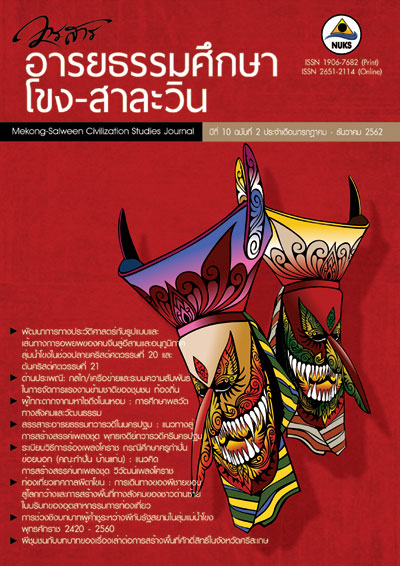Phu Tai Katak from Mahaxay to Non Hom : A study of the social and cultural dynamics Phu Tai Katak from Mahaxay to Non Hom : A study of the social and cultural dynamics
Main Article Content
Abstract
The article aims to study the social and cultural dynamics of the Phu Tai Katak ethnic group. It attempts to gather knowledge about local history, culture and traditions of Phu Tai Katak rites and to study the dynamics of traditional culture and function of folklore of the Phu Tai Katak ethnic group of Non Hom Village . This study uses the methodology of folklore research which fieldwork data collection in Thailand and Loas, participatory observation and in-depth interview with key informants. It was found that the local history of the Phu Tai Katak, Non Hom is linked to the migrations of Phu Tai ethnic group migrants into Thailand during the reign of King Rama 3 to King Rama 5. The Phu Tai Katak have their own indigenous culture, tradition, rituals and beliefs that are related to the teachings of Buddhism. In addition, they believe in supernatural powers by following the beliefs of neighboring people in the Northeast such as taking the Heet Sip Song as a framework of living and other available myths, legends and folk tales of the community related to the legend of Nong Han. This study is important in the field of social and cultural dynamics as it was found that many traditions and rituals of the villagers are dynamic or changing as compared to those that exist in the modern culture and society, under the influence of globalization. However, efforts are still being made to preserve the traditions and rituals in various ways such as measures for the preservation of language and revivalism of ancient traditions including the identification of costumes, rituals and events that promote cultural tourism in the community of Phu Tai World.
Downloads
Article Details
References
Aphiwatanasiri, U. Scholars of Ban Non Hom Village, Interviewed on April 13, 2017.
Chathiphot, P. (2017). The Social and Cultural dynamics of the Phu Tai Katak Ban Non Hom. Sakon Nakhon: Sakon Nakhon Rajabhat University.
Fangsai, W. Teacher of Ban Non Hom Village, Interviewed on April 13, 2017.
Fine Arts Department. (1999). Prachum Pongsawadan Kanjanapisek Version Volum 4. Bangkok: Pimlak.
Kedthes, B. (2009). The Inherritance. Kalasin: Prasarn Publishing.
Khaipraphai, D. Villager of Ban Non Hom Village, Interviewed on April 13, 2017.
Narasaj, B. (2009). History of Isan Wisdom. Khon Kaen: Center for Research on Plurality in the Mekong Region (CERP) Khon Kaen University.
Nathalang, S. (2014). Theory and science of criticism for Thai folk literature. Bangkok: Chulalongkorn University.
Plianek, P. Villager of Ban Non Hom Village, Interviewed on April 13, 2017.
Plianek, S. Folk Healer of Ban Non Hom Village, Interviewed on April 13, 2017.
Plianek, J. Villager of Ban Non Hom Village, Interviewed on April 13, 2017.
Premjit, S. and Dore, T. (1996). Etienne Aymonier’s Memoir of Travel in Lao, 1895. Chiang Mai: Social Research Institute.
Prince Damrong Rajabubhab. (2000). Tales of Archeology. Bangkok: Bannakharn.
Romrasri, J. Scholars of Ban Non Hom Village, Interviewed on April 13, 2017.
Srisontisuk, S. (2000). Impact of education on changing attitudes and values of the community of Phu Tai Ethnic Group, Ban Non Hom Tambol Non Hom Amphoe Mueang Sakon Nakhon Province. Khon Kaen: Khon Kaen University.
_______. (2001). The Study of the Phu Tai Ethnic Community Structure at Ban Non Hom, Tambol Non Hom< Amphoe Muang Changwat Sakon Nakhon. Khon Kaen: Khon Kaen University.
Thipakornwong, Chao Phraya. (1995). Pra Ratchapongsawadarn Krung Rattanakosin Ratchakarn Ti 3, The history of Rattanakosin period in reign King Rama 3. Bangkok: Fine Arts Department.
Uttawongsa, J. Villager of Ban Non Hom Village, Interviewed on April 13, 2017.
Verathawemas S and Thangsakul N. (2009). Phutai Vernacular Houses in Lao PDR. Khon Kaen: Center for Research on Plurality in the Mekong Region (CERP) Khon Kaen University.
______. (2016). Creative Folklore: Synthesis and theories.Bangkok: Princess Maha Chakri Sirindhorn Anthropology Centre (Public Organisation).
Yaisingsorn, A. Storyteller of Non Hom Village, Interviewed on April 13, 2017.


